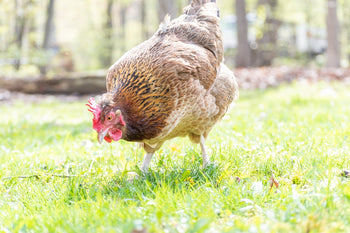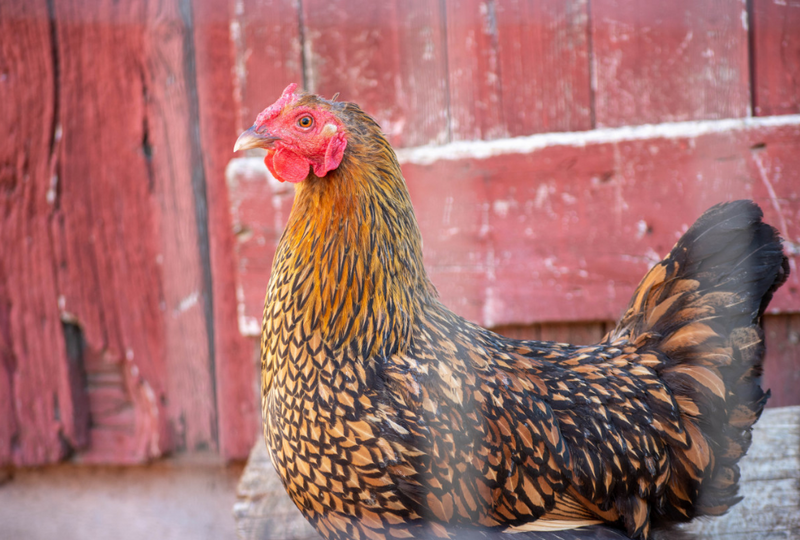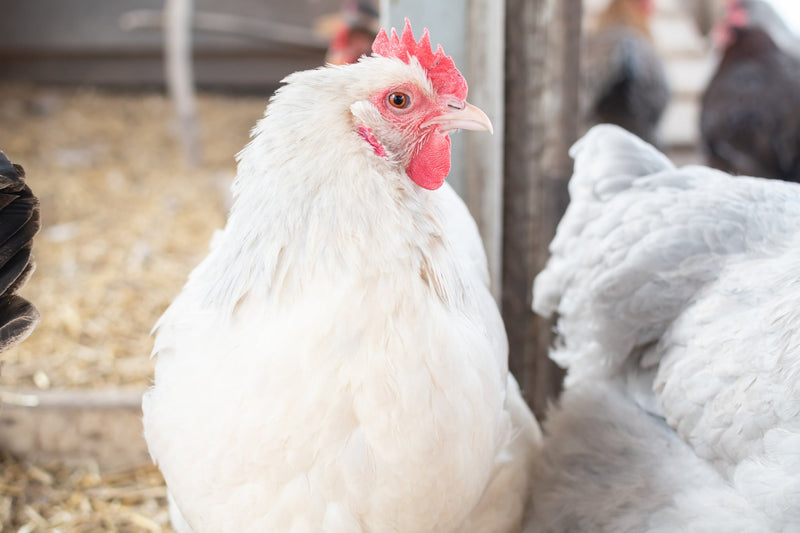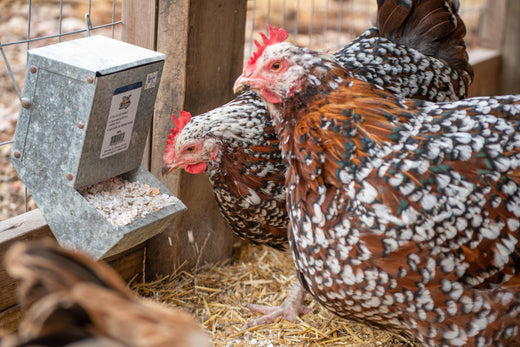Chicken combs and wattles come in all different shapes and sizes depending on the chicken’s breed and sex. However, these two features play an important role in a chicken’s health and reproduction. You can learn to gauge the well-being and productivity of a hen based on her comb. Comb and wattle size may also play a role in what chicken breeds you choose to get for your backyard flock. Let’s learn all about chicken combs and wattles!
What are Chicken Combs?
A chicken’s comb is a fleshy organ located on the top of its head. As odd as it may seem, the comb is considered an organ, just like the heart or kidneys. The comb is always located at the top of a chicken’s head but may come in many different shapes and sizes.
There are nine different recognized comb types (determined by breed) and there can be several different varieties within each one. The names of the comb types are often descriptive of their shape.
Here are the nine chicken comb types and a few breeds that sport each comb:
Single: One of the most common types, the single comb is an upright, thin comb type with points off the top and a rounded blade at the back. Some chicken breeds with a single comb include the Leghorn and Rhode Island Red.
Pea: The pea comb is small and rounded with many wrinkles. Ameraucana chickens and Brahma chickens are two examples of breeds that have the pea comb.
Buttercup: The buttercup comb is like a dual version of the single comb. It has two rows of points on either side of the base of the comb, and the two rows join at the blade to create a cup. This comb is very rare and sported by the endangered Sicilian Buttercup chicken breed.
Strawberry: Strawberry combs have a strawberry-like appearance. They are large and sit forward on a chicken’s head. The Malay and the Yokohama are two chicken breeds who have the strawberry comb.
Walnut: The walnut comb is large with many deep wrinkles. It also sits forward on the head and is often mulberry-colored. Silkie chickens and Orloff chickens are two examples of breeds that have the walnut comb.
Rose: Rose combs are small and often flat. They can have a spike off the blade part of the comb, and they often have a nubby appearance. The Wyandotte and Dominique are two chicken breeds with a rose comb, and the bantam Rosecomb includes a spike.
Cushion: The cushion comb is like a smaller version of the strawberry comb with less texture. The Chanticleer chicken has a cushion comb.
Carnation: The carnation comb is a variety of the single comb. It has extra points on the blade portion of the comb. This comb type is not very common and is found on Empordanesa chickens and Penedesenca chickens.
V-comb: As you might guess, the v-comb is a two-pointed comb in the shape of a V. Two examples of breeds include the La Fleche and Sultan.

Why Do Chickens Have Combs?
A chicken’s comb is an important organ for helping it maintain a proper body temperature during cool or hot weather.
Since chickens can’t sweat, they rely on other methods for staying cool during hot weather. The comb has a high concentration of blood running through it on a constant basis. This blood circulation helps to cool a chicken down during hot weather. It dissipates body heat and cools the blood when the air temperature is cooler than a chicken’s body temperature (104°F).
During cold weather, a chicken will often restrict circulation to its comb to help conserve body heat and prevent heat loss from the comb. While the restricted circulation prevents body heat from dissipating, it also causes the comb to be more prone to frostbite during cold temperatures.
A chicken’s comb can also help you gauge the health of the chicken. Notice the color and size of the comb to determine if the chicken is healthy and productive. Normal color ranges from red to purple or black depending on the chicken’s breed. Pullets and hens who are not laying have smaller, pale, pink-colored combs.
A pale and shrunken or shriveled-looking comb indicates that a chicken is in poor health. Here are some additional visual comb indicators to look for:
Pale & Shrunken: Anemic from blood loss, heat stress.
Dry & Flat: Dehydrated.
Blue-Colored: Restricted circulation, respiratory issues, cold stress.
Bright Red: Could indicate fever (healthy, productive birds will also have vibrant and full combs. A feverish chicken would also be showing signs of sickness, such as lethargy, shriveled comb & wattles, and a decrease in food and water consumption).
Spotted: White or black spots can indicate frostbite, gray or white lesions that develop into black scabs are a sign of fowl pox (a contagious viral disease).
Lastly, a chicken’s comb also plays an important role in a chicken’s sexual attraction to others of its species. Hormones and comb growth are directly related. As a chicken matures and its reproductive hormones start increasing, its comb starts to get bigger and fuller.
In general, cockerels start experiencing those growth hormones sooner than pullets, which causes them to develop larger combs faster than pullets. Mature roosters have larger combs than hens of the same breed.
Both hens and roosters use comb size as a way of selecting mates that are healthy and fit. A chicken with a vibrant red comb that is large and full indicates that the chicken is sexually healthy and fit. Studies show that hens are more attracted to a rooster with the largest and brightest comb.
It is also thought that chickens use combs as a way of recognizing each other and differentiating between members of their flock.

Do All Chickens Have Combs?
Yes, all chickens have combs. However, some comb types are smaller than others which can give a chicken the appearance of having little to no comb at all. Chicken breeds with small combs are often more cold hardy since they are less likely to restrict circulation to their comb during cold weather. This makes them more resistant to frostbite and less likely to experience cold stress during the winter.
Chicken breeds with large, tall combs are usually more heat tolerant since their combs are bigger and better at dissipating body heat.
While it may not look like chicks have combs, they simply have smaller combs that haven’t developed yet. As the chicks mature, their combs start to grow and become more noticeable. In some breeds, it is easy to tell whether a chick is a rooster or a hen based on the size of its comb as it matures.
Dubbing is the practice of cutting a chicken’s comb down to the cushion (base of the comb) and cutting the wattles off down to the skin. This was done for cockfighting breeds to minimize blood loss during cock fights. Cock fighting has since become illegal in many countries, so the practice of dubbing fighting breeds is now frowned upon. However, some chicken breeds still require a dubbed comb and wattles in order to meet their breed standard.
Do Hens Have Combs?
Yes, hens have combs. A hen will have a smaller version of a rooster’s comb. A healthy, productive hen who is laying will have a larger and brighter comb compared to a hen who is not laying. During the fall molt or shorter winter days, you may notice that some of your hens have smaller combs, which just means they have stopped laying. Sometimes you can differentiate between the hens who are laying in your flock from the ones who aren’t laying based on their comb appearance.
What are Chicken Wattles?
A chicken’s wattles are the fleshy skin that hangs below a chicken’s beak. The wattles are in pairs and hang on either side of the beak. While they don’t come in as much variety as chicken combs, a chicken’s wattles can still vary in shape and size depending on the chicken’s breed.
Some chickens have long, oblong-shaped wattles. Other chicken breeds have short wattles that are more rounded in shape. Roosters have larger and longer wattles than hens of the same breed.
Bearded chicken breeds, or chickens with feathers below their beaks, often lack wattles or have very small wattles that are barely distinguishable amongst the beard feathers. Faverolle chickens, Silkies, and bearded-Polish chickens are breeds that have little to no wattles.
Why Do Chickens Have Wattles and What Do They Do?
A chicken’s wattles function in the same way as its comb. The wattles help with body temperature control, can act as a health indicator, and make a chicken more sexually attractive for mating. Like the comb, the wattles also have lots of blood flowing through them. That increased blood flow helps a chicken cool down during hot weather, but it also makes comb and wattle injuries bleed like crazy.
The wattles can act as a health indicator in the same way as a chicken’s comb. Look for shriveled, small, and pale wattles that can indicate poor health. Pullets and hens who are not laying naturally have smaller, paler wattles but the texture should still be smooth rather than shriveled or dry.
Do Hens Have Wattles?
Yes, hens have wattles. A hen’s wattles are often smaller than a rooster’s wattles. However, in bearded chicken breeds, the hens may have little to no wattles.
Conclusion:
What is a chicken comb? What is a chicken wattle? These two physical features of a chicken are important for helping a chicken control its body temperature, can be an indicator of the chicken’s health and productivity, and can advertise to other chickens that the chicken is fit and mature for mating. The comb is located on top of a chicken’s head and the wattles are located below a chicken’s beak. Knowing how to read your flock’s comb and wattles can help you raise a healthy and productive backyard flock!










